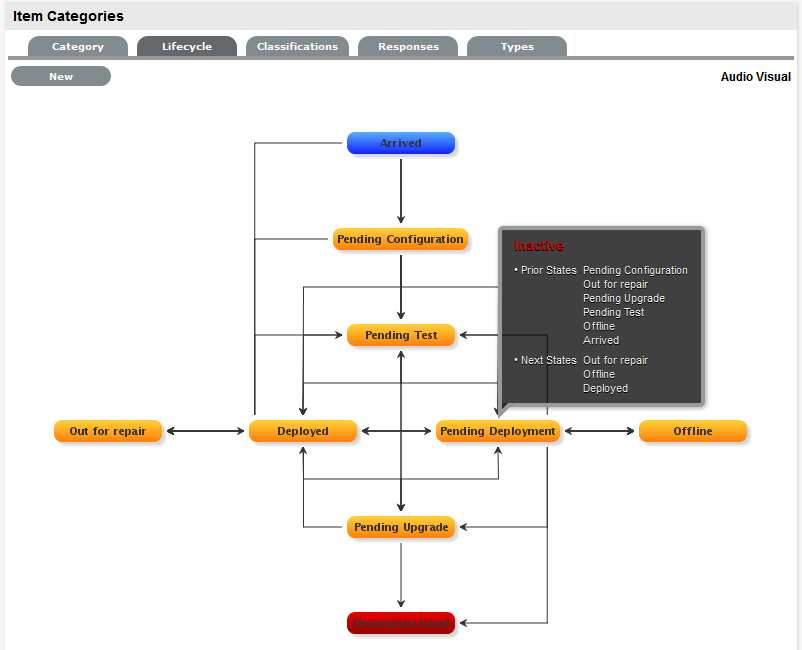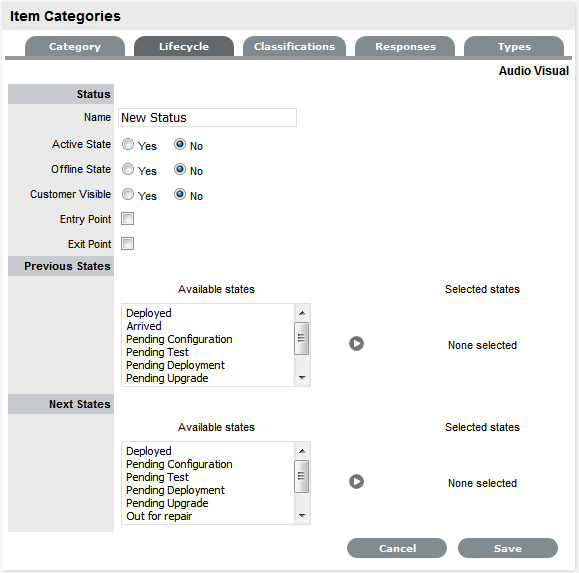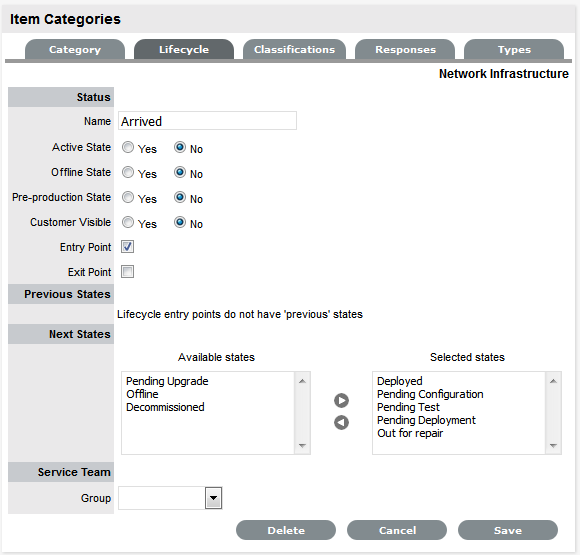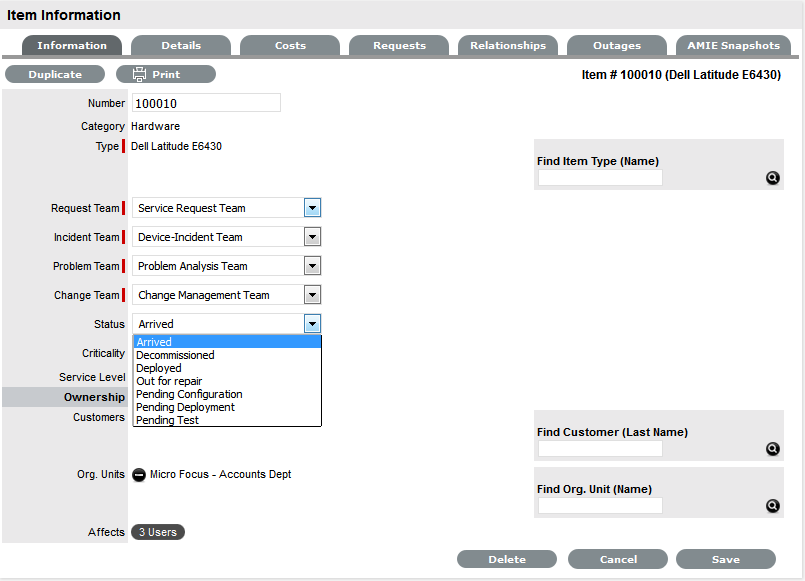1.32 Category Lifecycle
The Lifecycle details the stages of life for a Configuration Item. This allows Items to be tracked from the conceptualization/purchase stage through to being decommissioned/discarded, and can be used to indicate availability levels throughout the Lifecycle.
The States configured here are used within the Item information screen and allow the User to easily see if an Item is at a start or end point of its life, whilst also indicating if the Item is available or not. If an Item is moved to an Offline state, this information is also used on the Outage pages, for easy reference.
By default, the system is installed with some pre-defined Lifecycles, which are displayed with the three types of States:- Previous, Current and Next. Based on the configuration of the Current State, the listings displayed in the Previous or Next column show where an Item can move to from the Current State.
If the default Lifecycles do not match the requirements of the service and support organization, they can be customized. To avoid confusion, it is suggested that the default Lifecycle States be erased completely if they are not relevant to your organization.

1.32.1 Creating a Lifecycle
NOTE:It is recommended that all Lifecycle States be written down and mapped before this process is started.
-
Select Configuration>Categories
-
Click on the Item Category hyperlink
-
Move to the Lifecycle tab
-
Click the Current State hyperlink to edit the State, or, click New to create a new transitional State
The States/Status screen appears.

-
Rename the State as required
-
Complete the State configuration:
-
Description
Status
Name
Enter the name of the Lifecycle State.
Active State
Stipulates if the Item is Active, when assigned this State.
Offline State
Only visible when Active is set to No. Indicates if the Item is offline and inactive. Items moved into states where this is enabled, have availability metrics calculated.
Customer Visible
When selected, Items in this State are visible in the Customer Portal
Pre-production State
Only visible for Service Category lifecycle states. Items that use this state are available within the Service Pipeline filter view of the Configuration>Items tab.
Entry Point
An Entry Point is used to indicate the start of a Lifecycle. To make the state a Workflow Entry Point, select the Entry Point checkbox.
As the Entry Point is the first state, the Previous States field will be removed.
Exit Point
Select whether the state will be an Exit Point. An Exit Point is used to indicate the end of a Lifecycle.
Listener Class
This field is visible if the Outbound Webservices option is enabled in the Admin>Setup>Privileges>System tab.
Complete this field, if assigning an Item to this State is to trigger an event in an external system.
This field should contain the name of a Java class that implements the interface com.livetime.ws.listen.LifecycleListener that has been compiled into a jar file and added to the LiveTime classpath. Please contact support for further details.
NOTE:It is advised Users enter the list of all States, before defining any relationships to Previous or Next States
-
To return to the Lifecycle Current State list, save the updated State information
-
Continue editing, adding or deleting States until all relevant transitional States exist within the Lifecycle
After each Lifecycle State has been configured, the Lifecycle itself should be mapped.
-
Select a Current State hyperlink to configure the Previous State or Next State options,
Using all Available States entered in the Lifecycle, define the status direction options of an Item that uses this Item Category template.
-
Description
Status
Previous States
If the State is not an Entry Point, use the arrow button to select Previous States from the Available States.
Next States
If the State is not an Exit Point, use the arrow button to select the Next States.
Available States
Lists all the possible States that can be included in the Lifecycle.
Selected States
Lists the states that have been included as a Next or Previous State of the Lifecycle.
NOTE:When a State is used as a Previous or Next State, it allows an Item to move forward and backward in a Lifecycle
An Entry Point State cannot have any previous States and an Exit Point State cannot have any Next States.
-
Highlight the relevant States in the Available States box
-
Click the arrow pointing towards the Selected States box

-
When all States have been allocated, click Save
-
Save the assignment, and complete the process for all stages of the Item Lifecycle
-
Customise settings if editing a Service Category
Assign a Group within the associated Service Portfolio Team, this will allow these Users to edit the Item details when assigned this stage of the Category Lifecycl

-
Click Save.
Move to the Classifications tab, to define request Classifications for the Item.
1.32.2 Deleting a State
It may be necessary to delete a system default State or a State that is no longer in use. Note that a State cannot be deleted if it has been assigned to an Item.
To delete an unused State:
-
Select Configuration>Categories
-
Click on the Item Category hyperlink
-
Move to the Lifecycle tab
-
Select the Current State link
-
Click Delete.
Item Lifecycle Example
In this example the Item Category Hardware has a Lifecycle State of Arrived. This State is inactive and an entry point. Items assigned this State would not be visible on the Customer Portal.
After this State is assigned to an Item, the next State that the Item can move to is any of the States listed within the Selected States list (i.e., Deployed, Pending Configuration, Pending Test, Pending Deployment or Out for Repair).
Setting up the Lifecycle Status "Arrived"

1.32.3 Assigning the Lifecycle Status of Arrived to an Item with the Category Hardware
NOTE:The Item Status list contains all the States defined as Next States for the Arrived Status.
